
Station Name: ST. LUKES[Source:Tony Graham &
Paul Wright]
old8.jpg) The railmotor known as ‘Altcar Bob’ which operated on services between Southport Chapel Street and Downholland is seen at St Lukes Preston-direction platform in the late 1920s. The railmotor was on a service to Downholland. After leaving St Lukes it would fork to the east at the Meols Cop Triangle and join the former Liverpool Southport & Preston Junction Railway.
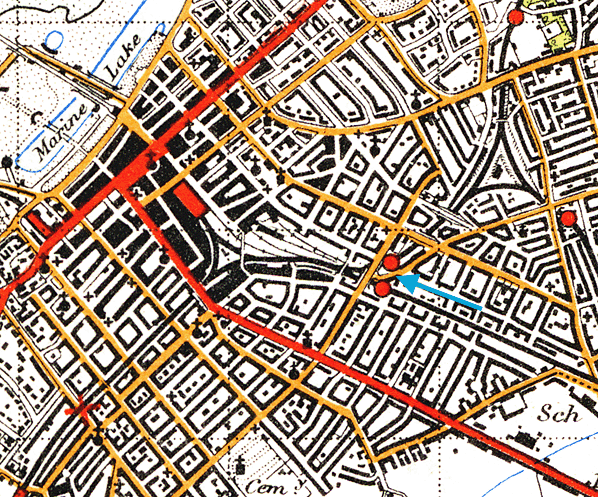  The original layout of St Lukes station an 1894 1:2,500 OS map before the WLR had been absorbed by the LYR. At this time the WLR had their own station at Ash Street which
is also shown on the map, 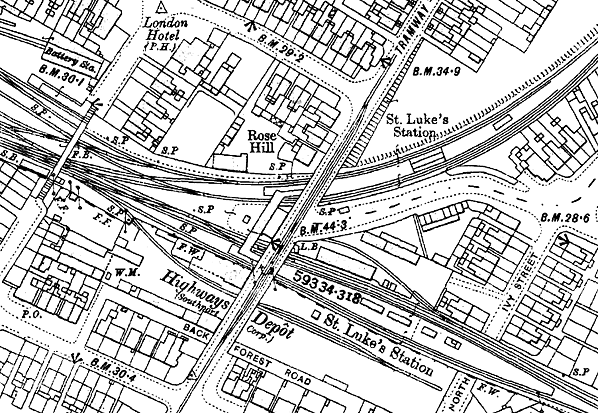 The remodelled St Lukes station as seen on a 1911 1:2,500 OS map. By this time a platform had been added on the former WLR line. A new booking office had also been provided on the road overbridge.
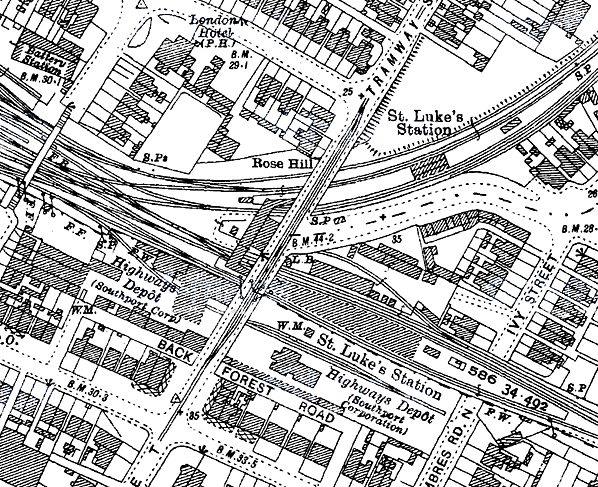 St Lukes station as shown on a 1928 1,2500 OS map; little has changed since 1911.
old6.jpg) Looking east towards St Lukes station from Windsor Road footbridge in April 1939. An EMU of LYR vintage had just departed from the St Lukes Preston-line platform and was en route to Southport Chapel Street on a working from Crossens. The driver had forgotten to alter the destination blind to read ‘Southport’. The end of the St Lukes Preston platform can be seen to the far left. Directly ahead is the original St Lukes platform that served the Wigan line. The buildings to the right, served by a siding, were the Southport Corporation highways depot.
Photo from John Mann collection street_old1.jpg) Looking east from Windsor Road footbridge towards St Lukes station in October 1953. The LMS-built EMU of 1938 vintage is working a Southport Chapel Street to Crossens service and is approaching the Preston line platform at St Lukes, which can be seen under the bridge on the left. The Wigan line platform at St Lukes can be seen on the right.
Copyright photo by ER Morten. Click here for more pictures by ER Morten 'Rail Cameraman 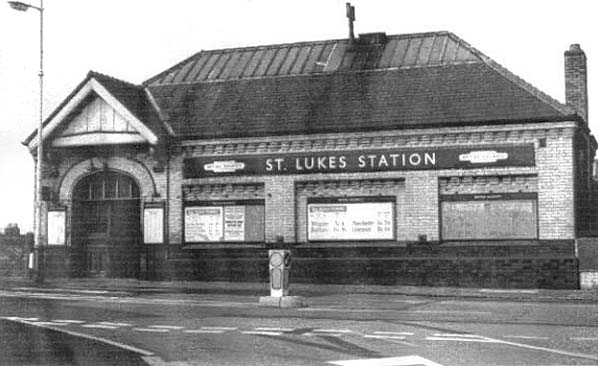 St Lukes station street level entrance c.1960s.
Photo received from Steve Wright old4.jpg) Looking north-east along St Lukes Preston line platform in August 1964. Locomotive number 45337 was arriving at the station on a Preston to Southport Chapel Street service. 45337 entered service as 5337 in April 1937. Built to the successful Stanier Black Five design by Armstrong Whitworth, it received the 4 prefix at nationalisation when it was shedded at 26B, Agecroft. Only six months after this picture was taken the locomotive was withdrawn, in February 1965, from Carlisle Kingmoor. The gentlemen's timber-built toilets on the Preston line platform are clearly shown. Also of interest is the live rail used by Crossens electric services.
old9.jpg) On 6 September 1964 Lostock Hall's BR Standard 2MT 2-6-0 No. 78040 brings the 13:17 Southport - Preston to a halt alongside St Lukes platform. Having been built for BR to a design by Riddles in 1954 this loco lasted until January 1966 when it was withdrawn from Lostock Hall and scrapped by TW Ward in May of that year. Tracks at this point were shared with services to Wigan Wallgate (via the Meols Cop route) and also with the electric
trains to Crossens. Copyright photo by Alan Castle old5.jpg) Looking south towards St Lukes station’s Preston line platform in early September 1968. At this time it was no longer possible to travel along the Preston line which had been closed for four years. Only Wigan line trains called, and within a week the station would close completely. The line through the station was still electrified but no passenger electrics ran. The live rails were retained for access to the electric car sheds at Meols Cop.
Photo by B Barlow 1.jpg) St.
Lukes station (Preston platform) looking east in June 1976.
Copyright photo by Nigel Mundy preston_platform5.jpg) St Lukes station's Preston line platform looking east in October 1982 fourteen years after it had closed. This platform was the last one to open and to close having survived until 1968. The Wigan line platform had closed four years earlier.
Photo by John Mann wigan_platform4.jpg) Looking east at the site of St Lukes station’s Wigan line platform (far left) in October 1982. By this time all traces of this platform had been swept away as had the route of the line running out through the eastern part of Southport. To the right is the site of the rail-served highways depot with a short section of loading platform in the distance. The building in the centre foreground is the weigh office. This has all been redeveloped for housing as can be seen in the aerial view below.
Photo by John Mann 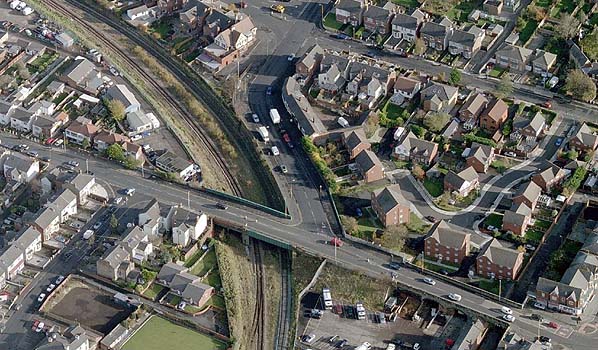 Mid 2000's aerial view showing the site of the two platforms. The Preston line platform served the line curving to the left, which was above the bridge. Immediately to the right of the bridge there is a grass bank, which is the infilled bridge for the Wigan line. The platform was above the bridge where the new houses are seen. The extant bridge to the right was for the line running through the highways depot which was sited either side of the bridge.
8.jpg) Looking east at the site of the former St Lukes Preston line platform in July 2011.
Photo by Paul Wright Click on thumbnail to enlarge
 Home
Page Home
Page
|




.gif)
1.jpg)






thumb7.jpg)
thumb9.jpg)
thumb10.jpg)
thumb11.jpg)
thumb12.jpg)
